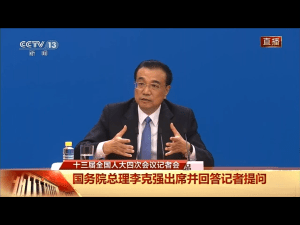
Against the backdrop of reopening after three years of zero-Covid policies, China’s outgoing Premier Li Keqiang has set out a GDP growth target of around 5% for 2023. This is lower than last year’s government target (5.5%), though consumption this year will receive a massive boost from the reopening.
In other words, Li’s 2023 GDP growth target, announced on March 4 in his last report, given during the “two sessions,” looks very conservative. Why is this?
First and foremost, the Chinese government, especially incoming premier Li Qiang, does not want to risk undershooting its growth target again, as happened in 2022.
Though consumption is recovering, external demand remains weak, and it is hard to know whether private investment will indeed jump, given doubts about the role of the private sector in the Chinese economy and increasingly cautious sentiment on the part of foreign investors. Furthermore, the real-estate sector is still dragging down growth.
Second, the Chinese government seems unwilling to push for a very lax fiscal policy to ensure higher growth. In particular, the budget deficit is set at 3% for 2023, slightly higher than last year (2.8%) but lower than 2020 (3.6%) and 2021 (3.2%).
In the same vein, the issuance of local-government special-purpose bonds, which is targeted at 3.8 trillion, is only moderately higher than the average for 2020 to 2022 (between 3.65 trillion and 3.7 trillion yuan) even at a time when land sales are expected to stagnate after more than a year of contraction.
Finally, in terms of monetary policy, the government continues to use the same wording as in past reports: Money supply and total social financing will be consistent with nominal economic growth. This also means that, so far, no credit binge should be expected or, in other words, monetary policy will not be used to push growth beyond the positive impact of the reopening.
In the longer term, the government’s push for a structural shift in the Chinese economy will continue. Over the last few years, tighter rules have been introduced to contain financial risk and achieve more social objectives, including greening the economy and food security.
This is an important signal that the Chinese government recognizes that over-high growth is no longer possible. Nor is it desirable, because it only creates further financial imbalances. Sustainable growth has become a key concept in China’s new economic narrative.
Against such a backdrop, job security is clearly one of the most important objectives. Li Keqiang’s final government report very much focused on the need for jobs, with a higher job-creation target of 12 million, compared with previous years (11 million, except for the even lower target in 2020 after Covid-19 hit China).
The higher employment target reflects the government’s concern about the job market, especially for young workers, almost 20% of whom were unemployed during spring 2022. In other words, the government wants to make sure that the current employment growth momentum, stemming from the reopening, is maintained throughout 2023.
This also explains Beijing’s recent charm offensive intended to maintain China’s large share of foreign direct investment, which constitutes a significant share of employment in manufacturing in the country.
Current moves toward supply-chain diversification will not help China meet the employment goal. Nor will the Chinese private sector, an even more important source of employment, unless the strict regulations that have hammered the tech sector, but also real estate, in the last few years are relaxed.
President Xi Jinping indicated, in his speech at the National People’s Congress in October 2022, that he expects more support from the private sector, but it remains unclear if he will get it.
The 5% growth target is thus consistent with the current challenges facing the Chinese economy and with the government’s more diversified objectives beyond economic growth. Creating more jobs is an essential part of China’s new sustainable growth narrative, explaining the higher employment-creation target with which Li Keqiang is bidding farewell.
However, Beijing must contend with the uncertainties around how interested foreign and Chinese private investors are in creating more jobs.
Alicia García Herrero is the chief economist for Asia-Pacific at Natixis. She also serves as senior fellow at the European think-tank Bruegel.

